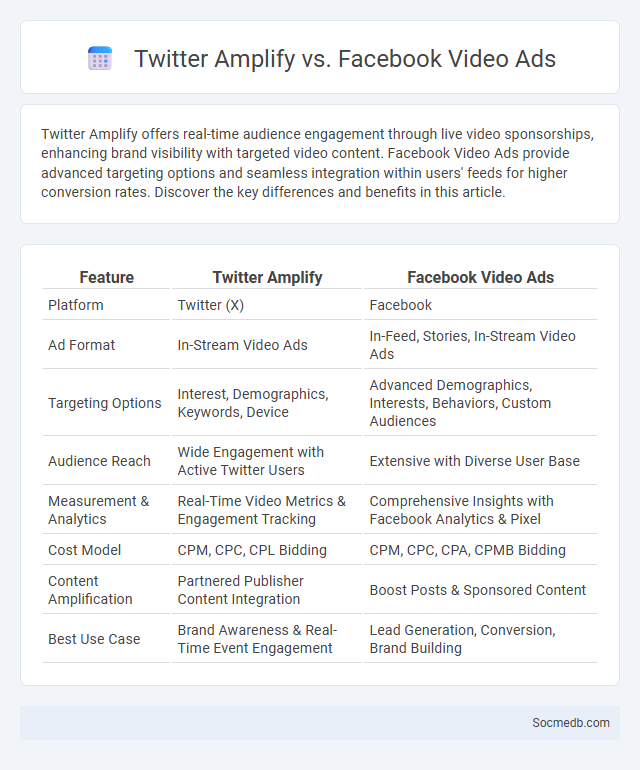
Photo illustration: Twitter Amplify vs Facebook Video Ads
Twitter Amplify offers real-time audience engagement through live video sponsorships, enhancing brand visibility with targeted video content. Facebook Video Ads provide advanced targeting options and seamless integration within users' feeds for higher conversion rates. Discover the key differences and benefits in this article.
Table of Comparison
| Feature | Twitter Amplify | Facebook Video Ads |
|---|---|---|
| Platform | Twitter (X) | |
| Ad Format | In-Stream Video Ads | In-Feed, Stories, In-Stream Video Ads |
| Targeting Options | Interest, Demographics, Keywords, Device | Advanced Demographics, Interests, Behaviors, Custom Audiences |
| Audience Reach | Wide Engagement with Active Twitter Users | Extensive with Diverse User Base |
| Measurement & Analytics | Real-Time Video Metrics & Engagement Tracking | Comprehensive Insights with Facebook Analytics & Pixel |
| Cost Model | CPM, CPC, CPL Bidding | CPM, CPC, CPA, CPMB Bidding |
| Content Amplification | Partnered Publisher Content Integration | Boost Posts & Sponsored Content |
| Best Use Case | Brand Awareness & Real-Time Event Engagement | Lead Generation, Conversion, Brand Building |
Overview: Twitter Amplify, Facebook Video Ads, and Amplification
Twitter Amplify enables brands to connect with live event audiences by pairing premium video content with targeted advertisements, driving real-time engagement and brand visibility. Facebook Video Ads offer advanced targeting options and immersive formats, maximizing reach and viewer interaction across diverse demographics. Amplification strategies leverage these tools to boost content distribution, ensuring higher engagement rates and improved return on ad spend.
Platform Reach and Audience Targeting Capabilities
Social media platforms offer extensive reach, enabling you to connect with billions of active users worldwide across networks like Facebook, Instagram, TikTok, and LinkedIn. Advanced audience targeting capabilities allow precise segmentation based on demographics, interests, behavior, and location, maximizing ad relevance and engagement. Leveraging these tools ensures your marketing campaigns effectively reach and resonate with your ideal customer base.
Video Ad Formats: Twitter Amplify vs Facebook Video Ads
Twitter Amplify offers sponsored video ads that appear alongside premium content from publishers, enhancing brand visibility within relevant conversations. Facebook Video Ads provide highly customizable targeting options and interactive features such as calls-to-action and in-stream ads, optimizing engagement and conversion rates. Your choice between these platforms should consider the audience demographics and ad format capabilities to maximize campaign performance.
Amplification Strategies: Paid vs Organic Approaches
Amplification strategies on social media involve a balance between paid and organic approaches to boost content visibility. Paid strategies utilize targeted advertisements and sponsored posts to reach specific demographics, increasing engagement quickly and efficiently. Your brand can achieve sustained growth by combining organic methods, like authentic community engagement and consistent content sharing, with strategic paid campaigns for maximum reach and impact.
Engagement Metrics and Performance Tracking
Engagement metrics such as likes, shares, comments, and click-through rates are crucial indicators of how well your social media content resonates with your audience. Monitoring performance tracking tools like Google Analytics and native platform insights enables you to analyze user interaction patterns and optimize your content strategy. By leveraging these metrics, you can effectively enhance your social media presence and achieve targeted marketing objectives.
Cost Structures and Budget Considerations
Social media cost structures predominantly include expenses for content creation, advertising campaigns, platform management tools, and influencer partnerships. Budget considerations must account for varying advertising costs across platforms like Facebook, Instagram, and LinkedIn, with CPM (Cost Per Mille) rates ranging from $5 to $12 depending on targeting specificity. Effective budget allocation balances organic growth efforts with paid promotions to maximize ROI while minimizing customer acquisition costs.
Creative Flexibility and Content Customization
Creative flexibility empowers your social media strategy by allowing you to experiment with various formats such as videos, stories, reels, and carousels tailored to your audience's preferences. Content customization enhances engagement by delivering personalized messages and visuals that resonate with specific demographics, increasing reach and interaction. Leveraging data analytics and platform-specific tools helps optimize your content strategy, driving higher conversions and brand loyalty.
Brand Safety and Ad Placement Controls
Ensuring brand safety and precise ad placement controls on social media platforms protects Your brand from associating with harmful or inappropriate content, preserving trust and reputation among your audience. Advanced algorithms and manual review processes work together to filter out non-compliant environments, reducing the risk of negative exposure and ad fraud. Leveraging customizable ad placement settings allows You to target relevant demographics while maintaining strict brand guidelines across multiple social channels.
Case Studies: Success Stories and Industry Examples
Case studies in social media marketing reveal how brands like Nike increased engagement by leveraging user-generated content and targeted influencer partnerships. For instance, Airbnb's personalized content campaigns boosted bookings by 30% through strategic storytelling and local experience highlights. These industry examples demonstrate measurable ROI improvements by aligning content strategies with audience interests and platform algorithms.
Choosing the Right Platform for Your Video Marketing Goals
Selecting the right social media platform for your video marketing goals depends on understanding audience demographics, content format preferences, and engagement patterns. Platforms like YouTube excel in long-form video content with broad reach, while TikTok and Instagram favor short, visually engaging clips ideal for younger audiences. Tailoring your video strategy to fit each platform's unique algorithms and user behavior maximizes visibility and engagement for your brand.
 socmedb.com
socmedb.com